Nec VERSA 6230, VERSA 6260, VERSA 6220 user Manual

NEC Computer Systems Division,
A Division of Packard Bell NEC, Inc.
DECLARATION OF CONFORMITY
We, the Responsible Party
NEC Computer Systems Division
Packard Bell NEC, Inc.
1414 Massachusetts Avenue
Boxboro, MA 01719
(978) 264-8000
declare that the product
NEC V6220/6230/6260
is in conformity with part 15 of the FCC Rules. Operation of this product is subject to the following two conditions: (1) this device may not cause harmful interference, and (2) this device must accept any interference received, including interference that may cause undesired operation.
PROPRIETARY NOTICE AND LIABILITY DISCLAIMER
The information disclosed in this document, including all designs and related materials, is the valuable property of NEC Computer Systems Division, Packard Bell NEC, Inc. (NECCSD, PBNEC) and/or its licensors. NECCSD and/or its licensors, as appropriate, reserve all patent, copyright and other proprietary rights to this document, including all design, manufacturing, reproduction, use, and sales rights thereto, except to the extent said rights are expressly granted to others.
The NECCSD product(s) discussed in this document are warranted in accordance with the terms of the Warranty Statement accompanying each product. However, actual performance of each such product is dependent upon factors such as system configuration, customer data, and operator control. Since implementation by customers of each product may vary, the suitability of specific product configurations and applications must be determined by the customer and is not warranted by NECCSD.
To allow for design and specification improvements, the information in this document is subject to change at any time, without notice. Reproduction of this document or portions thereof without prior written approval of NECCSD is prohibited.
FaxFlash is a service mark of NEC Computer Systems Division (NECCSD), Packard Bell NEC, Inc.
NEC is a registered trademark, Versa is a U.S. registered trademark, MiniDock, VersaBay, VersaGlide, and PortBar are trademarks, and UltraCare is a U.S. registered service mark of NEC Corporation, used under license.
All other product, brand, or trade names used in this publication are the property of their respective owners.
First Printing — January 1998
Copyright 1998
NEC Computer Systems Division, Packard Bell NEC, Inc.
1414 Massachusetts Avenue
Boxborough, MA 01719
All Rights Reserved

Using this Guide
The NEC Versa® User’s Guide gives you the information you need to maximize the use of your NEC Versa notebook computer. Read this guide to familiarize yourself with the NEC Versa and its features. For specific information see
TChapter 1, “Getting Started,” to acquaint yourself with system hardware.
TChapter 2, “Introducing the Software,” for a concise summary of the applications loaded on your system. We included software to let you experience the full spectrum of the system, from transferring files without cables to creating vivid presentations.
TChapter 3, “Using BIOS Setup,” to customize your notebook’s parameter and power management settings.
TChapter 4, “Using Your NEC Versa,” for an understanding of NEC Versa features and functionality. You’ll also master procedures for connecting external options like an external monitor, headphones, a printer, or speakers.
TChapter 5, “Using Multimedia,” for steps on integrating video and sound clips into impressive presentations.
TChapter 6, “Traveling with Your NEC Versa,” for valuable tips for getting the most out of your system while on the road.
TChapter 7, “Solving Problems,” for simple solutions to common problems that may arise while operating your notebook.
TAppendix A, “Setting Up a Healthy Work Environment,” for guidelines that help promote a healthy work setting.
TAppendix B, “Specifications,” to review NEC Versa system specifications.
TAppendix C, “Questions and Answers,” for a look at questions that users commonly ask and the answers to those questions.
Using this Guide ix
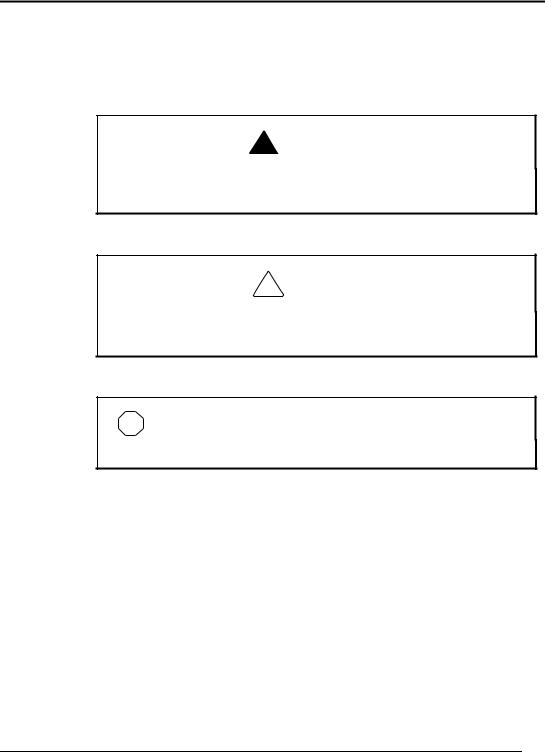
TEXT SETUP
To make this guide as easy to use as possible, text is set up as follows.
T Warnings, cautions, and notes have the following format:
! WARNING
Warnings alert you to situations that could result in serious personal injury or loss of life.
! CAUTION
Cautions indicate situations that can damage the system hardware or software.
NOTE
Notes give particularly important information about whatever is being described.
TNames of keys are printed as they appear on the keyboard, for example,
Ctrl, Alt, or Enter.
TText that you must type or keys that you must press are presented in bold type. For example, type dir and press Enter.
x Using this Guide

RELATED DOCUMENTS
See the following documents for additional information on your NEC Versa 6200 Series notebook computer:
TThe NEC Versa Quick Setup sheet helps get your system up and running.
TThe NEC Versa Quick Reference card provides an easy-to-carry reference to LED meanings, controls, function key combinations, and NECCSD help numbers. (The quick reference card does not ship with some systems purchased outside of the United States.)
TThe NEC Versa Help Center comes installed on your system. The Help Center is an online HTML document containing all of the information about your NEC Versa that you find in this printed user’s guide, and more.
Using this Guide xi

Contents
Using this Guide ...................................................................................................... |
ix |
Text Setup .................................................................................................. |
x |
Related Documents ..................................................................................... |
xi |
1 Getting Started |
|
Getting to Know Your NEC Versa ..................................................... |
1-2 |
Around the Front of the System..................................................... |
1-3 |
LCD Panel............................................................................... |
1-3 |
Control Panel........................................................................... |
1-4 |
Keyboard Panel and Base Unit ................................................. |
1-6 |
Around the Back of the System ..................................................... |
1-8 |
Around the Left Side of the System ............................................... |
1-9 |
Around the Right Side of the System ............................................. |
1-11 |
Around the Bottom of the System.................................................. |
1-12 |
Power Sources for Your NEC Versa .................................................. |
1-13 |
Using the AC Adapter................................................................... |
1-13 |
Powering On............................................................................ |
1-15 |
Using the Main Battery Pack......................................................... |
1-16 |
Determining Battery Status ...................................................... |
1-17 |
When to Change the Battery..................................................... |
1-18 |
Battery Handling...................................................................... |
1-18 |
Replacing the Battery Pack ...................................................... |
1-18 |
Battery Precautions.................................................................. |
1-22 |
Recharging Battery Precautions ............................................... |
1-23 |
Extending Battery Life ............................................................. |
1-23 |
NEC VersaBay II Battery and Adapter Kit.................................... |
1-23 |
Using the DC Car Adapter ............................................................ |
1-24 |
Internal Batteries .......................................................................... |
1-24 |
CMOS Battery ........................................................................ |
1-24 |
Bridge Battery ......................................................................... |
1-25 |
System Care ...................................................................................... |
1-25 |
Precautions................................................................................... |
1-25 |
Storage Requirements ................................................................... |
1-26 |
Routine Cleaning .......................................................................... |
1-27 |
Contents iii

2 Introducing the Software |
|
Windows Introduction........................................................................ |
2-2 |
Windows 95 ................................................................................. |
2-2 |
Windows NT ................................................................................ |
2-3 |
Windows for Workgroups ............................................................. |
2-4 |
DOS Introduction .............................................................................. |
2-5 |
Guide to Online Help ......................................................................... |
2-5 |
NEC Versa Help Center................................................................ |
2-5 |
Guide to NECCSD Utilities ............................................................... |
2-7 |
BIOS Setup Utility........................................................................ |
2-7 |
NEC Customize Utility ................................................................. |
2-7 |
Power Gauge Utility ..................................................................... |
2-7 |
HDPREPEZ Utility ...................................................................... |
2-8 |
Using HDPREPEZ in Windows 95 .......................................... |
2-8 |
Using HDPREPEZ in Windows for Workgroups...................... |
2-9 |
Other Software .................................................................................. |
2-9 |
LapLink file Transfer Software ..................................................... |
2-9 |
How to Use LapLink................................................................ |
2-10 |
McAfee VirusScan........................................................................ |
2-11 |
McAfee WebScan......................................................................... |
2-11 |
MediaMatics Arcade MPEG Player .............................................. |
2-11 |
XingMPEG Player........................................................................ |
2-11 |
Intel’s LANDesk Client Manager .................................................. |
2-12 |
MindPath Presentation FX ............................................................ |
2-12 |
CompuTrace™ ............................................................................. |
2-12 |
Online Services............................................................................. |
2-13 |
America Online........................................................................ |
2-14 |
CompuServe ............................................................................ |
2-14 |
AT&T WorldNet ..................................................................... |
2-15 |
Prodigy Internet Service Sampler ............................................. |
2-15 |
Browsers/Viewers......................................................................... |
2-15 |
Official Airline Guide (OAG)........................................................ |
2-16 |
3 Using BIOS Setup |
|
How to Enter BIOS Setup................................................................... |
3-1 |
BIOS Setup Utility Main Menu...................................................... |
3-2 |
How to Use BIOS Setup ..................................................................... |
3-2 |
Looking at Screens......................................................................... |
3-3 |
Using Keys .................................................................................... |
3-4 |
iv Contents

Checking/Setting System Parameters.............................................. |
3-4 |
BIOS Setup Menus ........................................................................ |
3-7 |
Standard CMOS Setup ............................................................. |
3-7 |
Advanced CMOS Setup ............................................................ |
3-7 |
Power Management Setup......................................................... |
3-8 |
Boot Device Setup .................................................................... |
3-10 |
Peripherals Setup...................................................................... |
3-10 |
Other BIOS Setup Options............................................................. |
3-11 |
Password Protection....................................................................... |
3-11 |
Using BIOS Setup to Set Power Management...................................... |
3-11 |
Using the Save to File (STF) Feature.............................................. |
3-12 |
STF Benefits ............................................................................ |
3-13 |
4 Using Your NEC Versa |
|
LCD Panel......................................................................................... |
4-1 |
Keyboard........................................................................................... |
4-2 |
NEC VersaGlide................................................................................ |
4-4 |
Making VersaGlide Adjustments ................................................... |
4-5 |
VersaGlide Tips............................................................................ |
4-6 |
NEC VersaBay II .............................................................................. |
4-6 |
Removing a Device from the VersaBay II...................................... |
4-7 |
Installing a Device in the VersaBay II............................................ |
4-9 |
Customizing Your System with the VersaBay II ............................ |
4-10 |
20X CD-ROM Reader ....................................................................... |
4-11 |
CD Loading.................................................................................. |
4-12 |
CD Care ....................................................................................... |
4-13 |
Changing the Auto Play Setting..................................................... |
4-14 |
Card Bus/PC Card Slots .................................................................... |
4-15 |
Inserting a PC Card ...................................................................... |
4-15 |
Removing a Card .......................................................................... |
4-16 |
Windows 95 and Windows NT................................................. |
4-16 |
Windows for Workgroups ........................................................ |
4-17 |
PC Card Drivers and Enablers ...................................................... |
4-17 |
PC Card Drivers and Utilities................................................... |
4-17 |
Enablers .................................................................................. |
4-19 |
CONFIG.SYS ......................................................................... |
4-20 |
CardWizard Services ............................................................... |
4-20 |
Reinstalling PC Card Software................................................. |
4-21 |
Available PC Cards ...................................................................... |
4-21 |
Communications Cards ............................................................ |
4-21 |
Contents v

Storage Cards .......................................................................... |
4-22 |
Other Cards ............................................................................. |
4-23 |
IR Port .............................................................................................. |
4-23 |
Installing IR Printer Drivers .......................................................... |
4-24 |
Configuring an IR-enabled Printer................................................. |
4-25 |
USB Port........................................................................................... |
4-25 |
Increasing System Storage and Memory ............................................. |
4-26 |
Hard Disk..................................................................................... |
4-26 |
Hard Disk Drive Bay Covers.................................................... |
4-30 |
Formatting the Hard Disk Drive ............................................... |
4-31 |
Using the Product Recovery CD............................................... |
4-32 |
Memory Module Installation ......................................................... |
4-34 |
Using External Options ...................................................................... |
4-41 |
External Monitor .......................................................................... |
4-41 |
Printer .......................................................................................... |
4-43 |
Parallel Devices ....................................................................... |
4-43 |
Serial Devices.......................................................................... |
4-44 |
External Keyboard/Mouse............................................................. |
4-46 |
External Bar Code Scanner ........................................................... |
4-47 |
External Television Connection ..................................................... |
4-47 |
External Audio Options................................................................. |
4-48 |
NEC Versa PortBar 6000 ............................................................. |
4-49 |
NEC Docking Station 6000 Plus ................................................... |
4-50 |
NEC MiniDock 6000.................................................................... |
4-50 |
Setting Switches ................................................................................ |
4-51 |
Updating the System BIOS ........................................................... |
4-52 |
Changing Switch Settings......................................................... |
4-53 |
Performing the BIOS Update.................................................... |
4-57 |
5 Using Multimedia |
|
Audio ................................................................................................. |
5-1 |
Recording ...................................................................................... |
5-1 |
Line-In .......................................................................................... |
5-3 |
CD-ROM Input ............................................................................. |
5-4 |
Microphone ................................................................................... |
5-4 |
Mixing........................................................................................... |
5-4 |
Playing Back ................................................................................. |
5-5 |
Using Headphones .................................................................... |
5-5 |
Using the Built-In Speakers....................................................... |
5-5 |
Using External Stereo Speakers................................................. |
5-6 |
vi Contents

MIDI Files..................................................................................... |
5-6 |
Video.................................................................................................. |
5-6 |
Using Digital Video Files ............................................................... |
5-7 |
Using Animation Files.................................................................... |
5-7 |
Multimedia Applications ..................................................................... |
5-7 |
6 Traveling with Your NEC Versa |
|
Power Connections ............................................................................. |
6-1 |
Checklists ........................................................................................... |
6-2 |
What to Take................................................................................. |
6-2 |
Preparing Your NEC Versa for Travel ........................................... |
6-2 |
7 Solving Problems |
|
Problem Checklist............................................................................... |
7-1 |
Start-up Problems............................................................................... |
7-3 |
POST Error Messages ................................................................... |
7-3 |
Using the Product Recovery CD.......................................................... |
7-7 |
Full Restore ................................................................................... |
7-7 |
Selective Installation ...................................................................... |
7-8 |
If You Need Assistance....................................................................... |
7-9 |
A Setting Up a Healthy Work Environment |
|
Making Your Computer Work for You................................................ |
A-1 |
Arrange Your Equipment .................................................................... |
A-2 |
Adjust Your Chair .............................................................................. |
A-2 |
Adjust Your Input Devices.................................................................. |
A-3 |
Adjust Your Screen or Monitor ........................................................... |
A-4 |
Vary Your Workday ........................................................................... |
A-5 |
Pre-Existing Conditions and Psychosocial Factors ............................... |
A-5 |
B Specifications |
|
Memory Map...................................................................................... |
B-7 |
Interrupt Controllers ........................................................................... |
B-8 |
C NECCSD Information Services |
|
How to Reach Us................................................................................ |
C-2 |
NECCSD Diskette Fulfillment Center ............................................ |
C-2 |
NECCSD Technical Support Center .............................................. |
C-2 |
NECCSD Customer Assistance Center........................................... |
C-3 |
NECCSD FaxFlash Service ........................................................... |
C-3 |
Contents vii

Using FaxFlash......................................................................... |
C-3 |
Ordering Information ................................................................ |
C-4 |
NECCSD Bulletin Board System (BBS)......................................... |
C-5 |
Logging On .............................................................................. |
C-5 |
Logging Off.............................................................................. |
C-7 |
NECCSD on CompuServe ............................................................. |
C-7 |
Using CompuServe ................................................................... |
C-7 |
NECCSD on America Online......................................................... |
C-8 |
Using America Online............................................................... |
C-8 |
NECCSD on the Internet................................................................ |
C-9 |
NECCSD WWW and FTP Sites ............................................... |
C-9 |
NECCSD E-Mail and Fax ............................................................. |
C-10 |
Warranty And Non-Warranty Repair Service ...................................... |
C-10 |
Glossary
Index
viii Contents
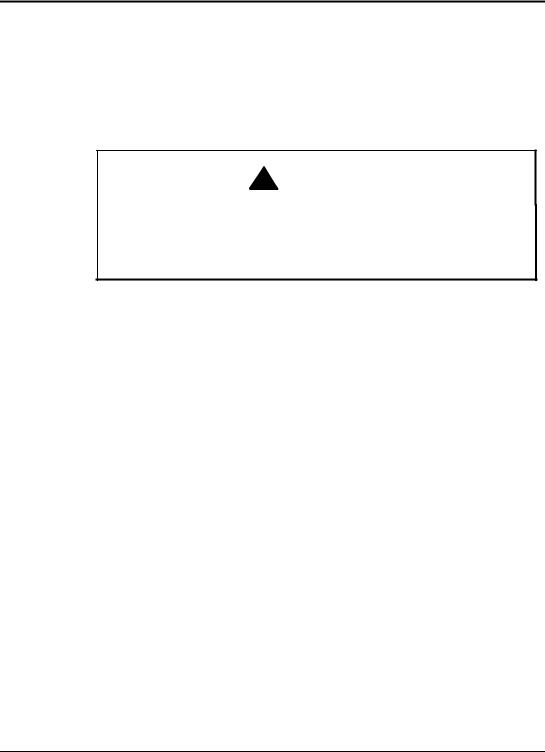
1 |
Getting Started |
! WARNING
Prolonged or improper use of a computer workstation may pose a risk of serious injury. To reduce your risk of injury, set up and use your computer in the manner described in Appendix A, “Setting Up a Healthy Work Environment.”
After completing the steps in the quick setup sheet that comes with your computer, your NEC Versa 6200 Series notebook computer is ready to go! To get started, look at the following:
TRead Appendix A, “Setting Up a Healthy Work Environment,” for guidelines that help you use your computer productively and safely. Information includes how to set up and use your computer to reduce your risk of developing nerve, muscle, or tendon disorders.
TTake the online System Tour to get acquainted with the NEC Versa. The System Tour is part of the NEC Versa Help Center.
TView the online system Basics. Basics is part of the NEC Versa Help Center.
TRead through this guide to familiarize yourself with the NEC Versa.
Getting Started 1-1
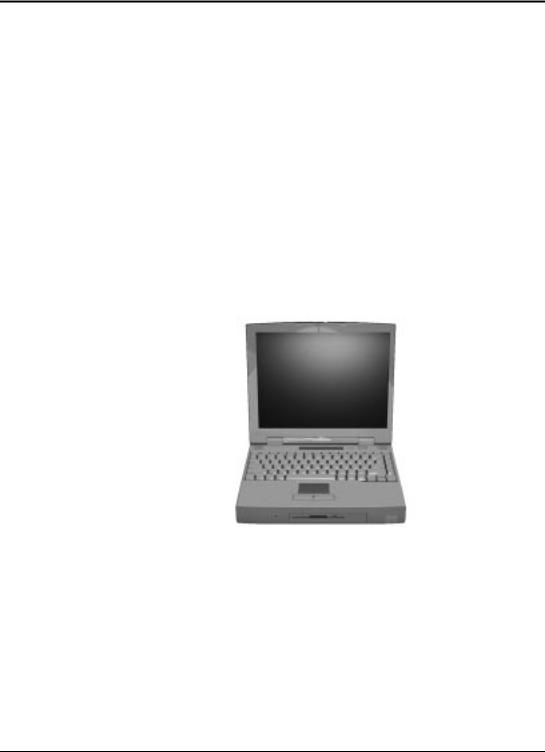
GETTING TO KNOW YOUR NEC VERSA
The NEC Versa 6200 Series notebook computer offers you a portable system filled with exciting resources for home, business or travel. Standard features include a powerful Intel® Pentium 200-MHz, 233-Mhz, or 266MHz microprocessor that works together with the latest Peripheral Component Interconnect (PCI) architecture.
In addition, your system provides a high-performance hard disk drive, diskette drive or SuperDisk LS-120 drive, interchangeable 20X CD-ROM reader, and PC Card support. As a multimedia system, your NEC Versa also provides the tools needed to create and present impressive images using video clips and sound. See the online Versa Tools: Accessories and Solutions for more information.
To get comfortable with your notebook, read the following sections and take a tour around your system!
NEC Versa 6200 Series notebook computer
1-2 Getting Started
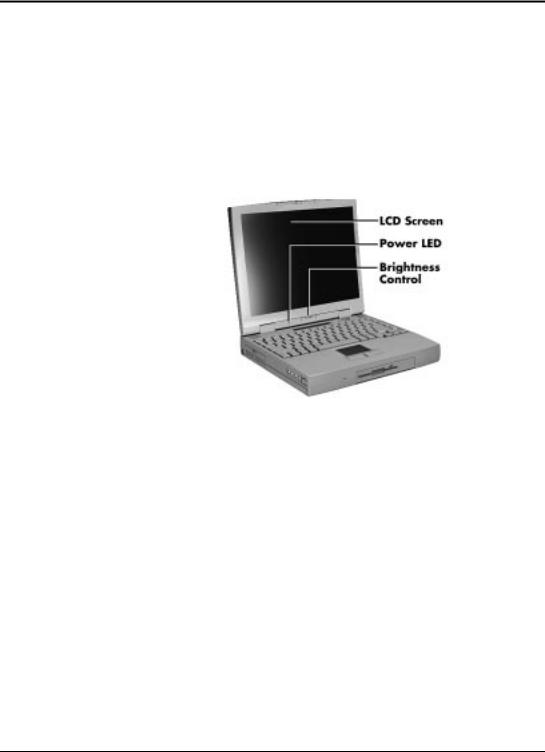
Around the Front of the System
The NEC Versa is compact with features on every side. First, look at the front of the NEC Versa. The following sections describe front features, beginning with the liquid crystal display (LCD) panel.
LCD Panel
The LCD panel on your system offers the features shown in the following figure. Features are described after the figure.
LCD panel features
T LCD — a 13.3-inch color Thin Film Transistor (TFT) Extended Graphics Array (XGA) display that you can easily adjust for comfortable viewing.
TPower LED — a light that is visible with the LCD panel opened or closed. The Power LED indicates the following:
¾Lights green when the system is powered on.
¾Blinks green when the system is in Suspend mode.
¾Slowly blinks amber to indicate that battery power is at 8% capacity or less.
¾Rapidly blinks green to indicate that battery power is at 4% capacity or less.
TBrightness Control — a slide switch that adjusts screen brightness.
Getting Started 1-3
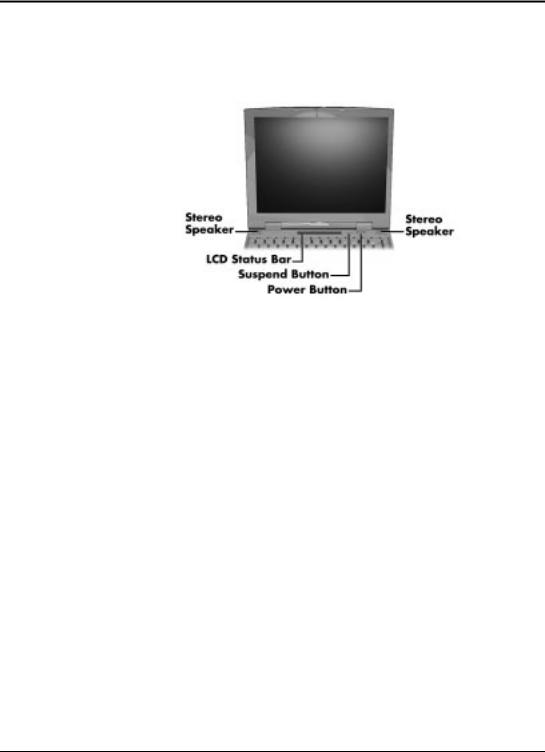
Control Panel
The NEC Versa control panel provides the features shown in the following figure. These features are described after the figure.
Control panel
TStereo Speakers — provide stereo sound for your multimedia presentations or listening pleasure. The built-in sound system also supports 3D sound, which simulates the latest surround-sound technology.
TLCD Status Bar — keeps you informed of your NEC Versa’s current operating status. Description of icons appear in the following section.
TSuspend/Resume (S/R) Button — press the S/R button to put the unit in Suspend mode when you need to be away from your system for a short period of time and want to return to where you left off. Press the S/R button again to bring the NEC Versa out of Suspend mode.
Suspend mode shuts down all devices in the system while retaining data and system status. Use the Fn Suspend key combination to initiate a manual save-to-file. Use the Smart power Switch (power button) to resume from a save-to-file. You can find more detailed information on using Suspend mode in Chapter 3, “Using Setup.”
1-4 Getting Started
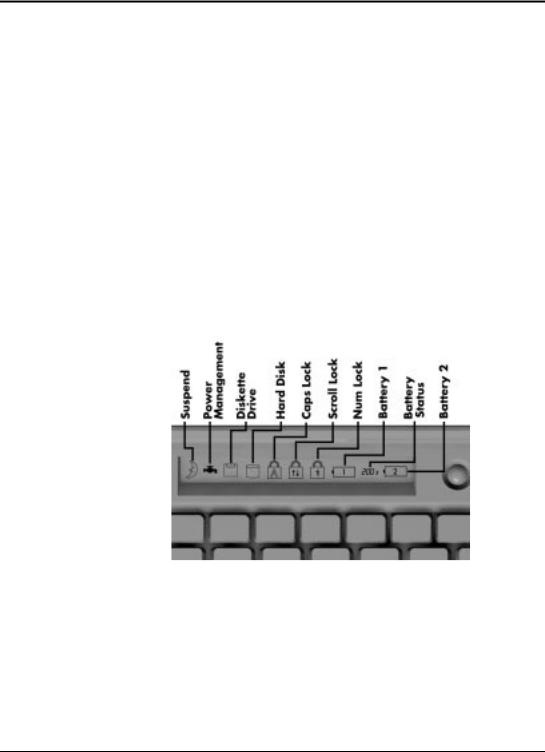
TPower Button — slide the power button to the right to power on and power off the computer.
The Power button is a “smart” switch, meaning that it recognizes when the system is in Suspend mode. If in Suspend mode, you cannot power off until you press the Suspend button again to bring it out of Suspend mode.
In addition, the Smart Power Switch invokes an orderly shutdown in the Windows 95 and Windows NT environments. If you use the Power button to turn off your system while applications are running, the Smart Power Switch alerts the operating system. The operating system prompts you to save all data and invokes an orderly shutdown procedure.
Status Icons
The NEC Versa 6200 Series uses LCD icons that communicate system status. See the following figure and list for each icon’s meaning.
Reviewing status icons
TSuspend — appears when the system is in Suspend mode. Suspend mode conserves system power by shutting down all devices in the system while retaining data and system status.
TPower Management — shows the current power management mode in use, including Off, Custom, Low, or High.
Getting Started 1-5
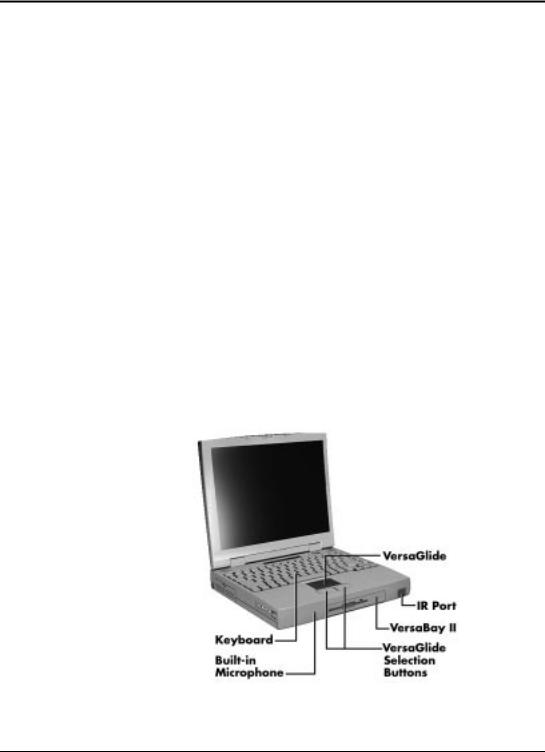
TDiskette Drive — appears when the NEC Versa writes data to or retrieves data from a diskette.
THard Disk — appears when the NEC Versa accesses either the hard disk drive or the CD-ROM reader.
TCaps Lock — appears when Caps Lock is in effect.
TScroll Lock — shows that Scroll Lock is in effect.
TNum Lock — appears when Num Lock mode is active.
TBattery Status — displays the percentage of battery power available.
¾Battery 1 appears when you have one or more batteries installed.
¾Battery 2 appears when you have an optional battery installed in the VersaBay II.
¾A number between the battery icons indicates the percentage of total battery power remaining. Before the battery is charged, dashes appear instead of a percentage.
Keyboard Panel and Base Unit
The NEC Versa keyboard panel and base unit contain the following features, which are described after the figure.
Keyboard and base unit
1-6 Getting Started

TNEC VersaGlide — The NEC VersaGlide works like a standard computer mouse. Simply move your fingertip over the VersaGlide to control the position of the cursor. Use the selection buttons below the VersaGlide to select menu items. VersaGlide settings and features are described in detail in Chapter 4.
TIR Port — The infrared (IR) port on the NEC Versa lets you send and
receive information from other IR-equipped devices such as printers or desktop computers. Using the LapLink® software, you can transmit,
receive, and gain access to files on a remote system. See “LapLink” in Chapter 2.
TNEC VersaBay II™ — A 1.44-MB diskette drive or SuperDisk LS-120 drive comes installed in the NEC VersaBay II on the front of your system. You can use the diskette or LS-120 drive, or remove it from the VersaBay II and replace it with the 20x CD-ROM reader that also ships with your system. It’s your choice!
TThe VersaBay II lets you add options, including an optional second Li-Ion battery, or an additional hard disk drive. See “Customizing Your System with the VersaBay II” in Chapter 4.
TMicrophone — A strategically positioned built-in microphone allows you to record monophonic sound directly into your notebook computer. See Chapter 5, “Using Multimedia,” for details about recording.
TKeyboard — 85 keys with the standard QWERTY-key layout. See Chapter 4 for complete details. (Models purchased outside of the U.S. ship with country-specific keyboard layouts.)
Getting Started 1-7

Around the Back of the System
You’ll find system ports for connecting optional devices (like printers, docking station, or external monitor) on the back of your NEC Versa. These ports are described following the figure.
Ports on the back of the system
TKeyboard/Mouse Port — Use the standard PS/2 port to connect an external PS/2-style mouse or a PS/2-style keyboard to the system. With an optional Y-cable adapter, you can connect both a mouse and a keyboard at the same time.
TParallel Port — Use this port to connect a parallel printer or other parallel device. The port is an Enhanced Capabilities Port (ECP). The ECP standard provides you with a greater processing speed than the
conventional parallel port. It also supports Enhanced Parallel Port (EPP) bi-directional and uni-directional protocols.
TExpansion Port — This port (also called the Docking port) provides a connection for NEC Versa 6200 Series options including the NEC Docking Station 6000 Plus, the NEC PortBar 6000, the NEC MiniDock 6000, and the NEC Floppy Disk Drive (FDD) Connector.
1-8 Getting Started
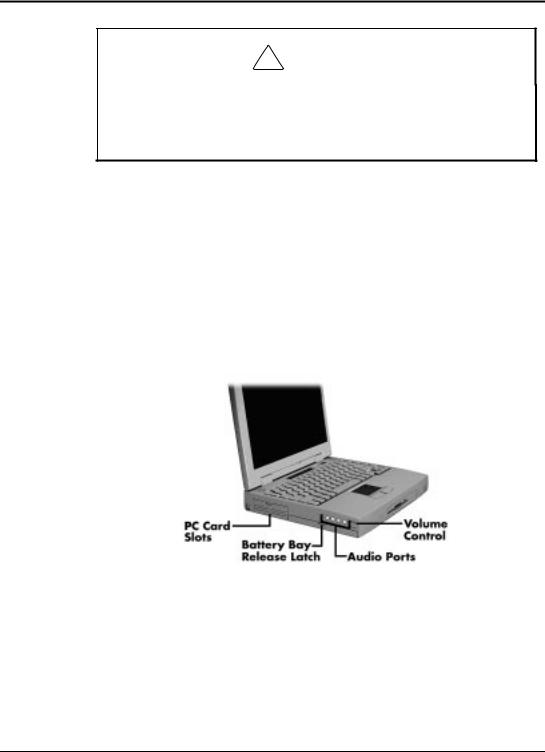
! CAUTION
Only dock the NEC Versa 6220, 6230, or 6260 on the NEC Docking Station 6000 Plus or the NEC MiniDock 6000. The cover of the docking station is specially designed to allow for proper system cooling.
TExternal Monitor (Video) Port — Use this 15-pin port to attach an external monitor to your NEC Versa. You can run the LCD display and the external monitor simultaneously or run either alone.
TSerial Port — Use this port to connect an external modem or other serial device.
Around the Left Side of the System
The left side of your NEC Versa offers the following features, which are described after the figure.
Left side features
TPC card slots — provides two slots for inserting two Type II PC cards or one Type III PC card.
TBattery bay and battery bay cover release latch. — Contains an eight-cell Lithium Ion (Li-Ion) battery that lets you run your system on DC power.
Getting Started 1-9

TAudio ports and a volume control knob.
¾Volume Control — Allows you to control the speaker volume.
¾Headphones — Lets you connect external headphones or speakers to your NEC Versa. Plugging in headphones disables the built-in system speakers.
¾Line-Out — Lets the NEC Versa act as an input source for another audio system. Connect this port to a Line-In port on another audio system to play or record.
¾Line-In — Lets you use another audio system, like a home stereo, as an input source. Use a cable to connect to the Line-Out port on the other audio system to record or play.
¾Microphone (MIC) — Allows you to connect an external microphone for monophonic recording or amplification through the unit. Plugging in an external microphone disables the built-in microphone.
1-10 Getting Started
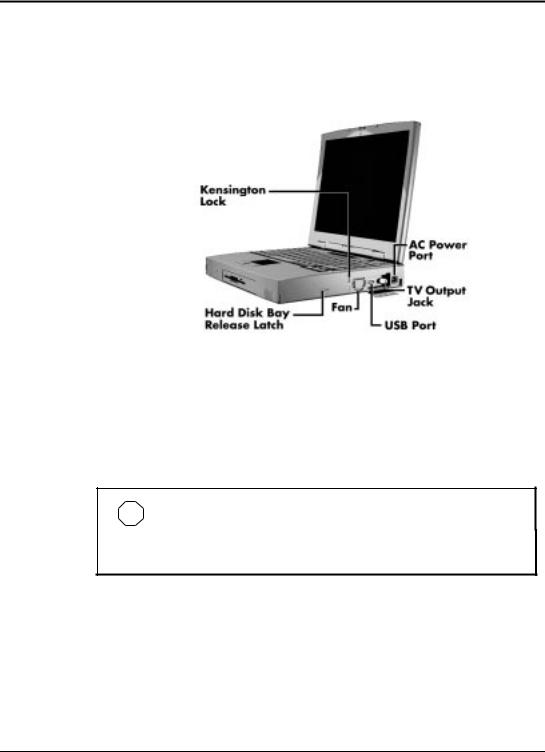
Around the Right Side of the System
The right-side of the NEC Versa offers the features shown in the following figure. Features are described after the figure.
Right side features
TAC Power Port — Use the power jack to attach the NEC Versa to a DC power source, such as the AC adapter or the optional DC car adapter.
TTV Out Port — Lets you use your television set as an external monitor. This port supports both NTSC and PAL signals.
NOTE
The TV Out port does not support the SECAM signal used in some countries. For proper display, video mode must be set to 640 x 480.
TUSB Port — The Universal Serial Bus (USB) port allows you to connect up to 127 USB equipped peripheral devices (printers, monitors, scanners, etc.) to your NEC Versa.
TFan Vents — Allow your system to cool properly and maintain a safe operating temperature.
Getting Started 1-11
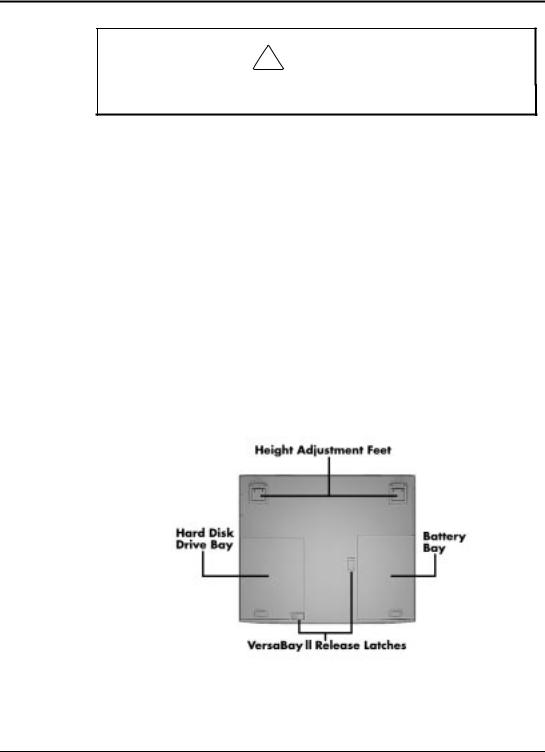
! CAUTION
Always keep the fan vents clear to allow proper system cooling.
TKensington Lock — Lets you provide added security by installing an optional Kensington Lock.
THard Disk Drive Bay and Cover Release Latch — The hard disk drive bay contains the removable hard disk drive. Your NEC Versa typically ships with either a 3.2 gigabyte (GB) or a 5.1 gigabyte (GB) hard disk drive (other capacities drives may be installed depending on your initial purchase configuration).
To access the hard disk drive, power off the system, turn the system over, remove the hard disk drive bay cover screw and lift up the hard disk drive bay cover release latch while pushing the cover away from the system.
Around the Bottom of the System
The bottom of the NEC Versa offers the features shown next. Descriptions of the features follow the figure.
Bottom features
1-12 Getting Started

TAdjustable Feet — Allow you to modify the angle of the NEC Versa for easier viewing and typing.
THard Disk Drive Bay — Contains the system’s hard disk drive.
TNEC VersaBay II Release Latches — Lets you remove the option currently installed in the bay.
TBattery Bay — Contains the system’s main battery. It is an eight-cell, Lithium-Ion (Li-Ion) battery.
POWER SOURCES FOR YOUR NEC VERSA
The NEC Versa can be powered using three different sources, making it a truly portable system. Operate your NEC Versa just about anywhere using one of the following power sources:
Tthe AC adapter connected to an electrical wall outlet (using AC power).
Tthe battery pack or an optional second battery pack.
Tthe optional DC adapter connected to a car cigarette lighter
Tthe optional PowerXtender™ Airplane and Auto adapter.
Read the following sections for specific steps on powering on the system.
Using the AC Adapter
Use the AC adapter and power cable that came with your NEC Versa to run your computer on alternating current (AC) power, or to recharge the battery pack. Use the AC adapter whenever a wall outlet is nearby.
Keep the adapter connected whenever possible. The AC adapter charges the battery whether or not you are using the NEC Versa or have the system powered on.
Getting Started 1-13
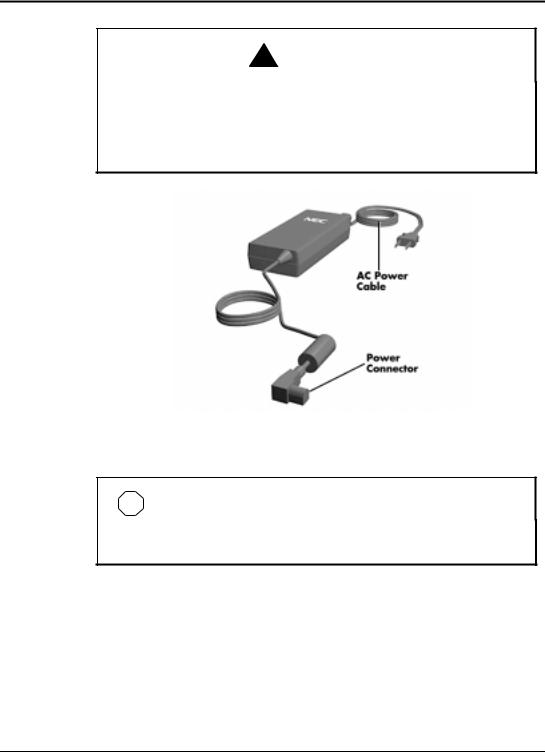
! WARNING
Do not attempt to disassemble the AC adapter. The AC adapter has no user-replaceable or serviceable parts inside. Dangerous voltage in the AC adapter can cause serious personal injury or death. The AC adapter is intended for use with a computer. Both must meet EN609050 standards.
AC adapter
NOTE
Check that the AC outlet voltage falls in the range of 100–240 Volts AC. Verify that the cord and plug are appropriate for your AC source.
Connect the AC adapter as follows:
1.Connect the AC adapter cable to the power port on the right side of your NEC Versa.
1-14 Getting Started
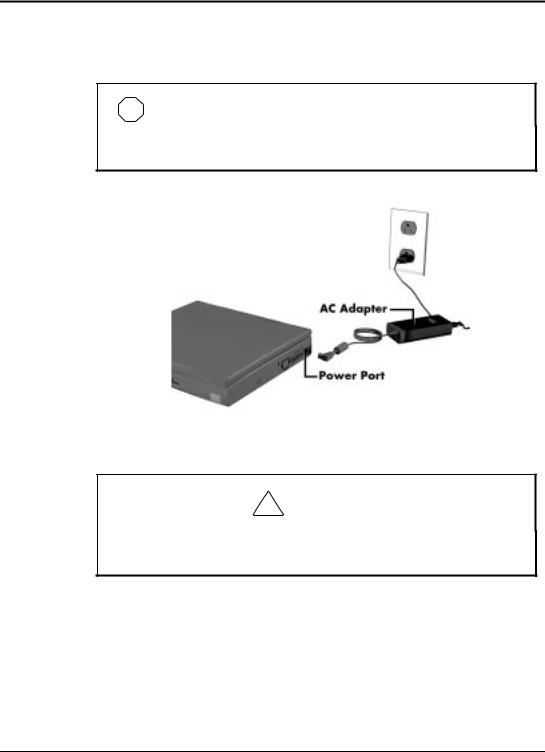
2.Plug one end of the AC power cable into the AC adapter and the other end into a properly grounded 120or 240-volt wall outlet.
NOTE
The AC power cable type that your system uses depends on the country where you are using it. Contact the local dealer to purchase the correct power cable.
Connecting the AC adapter
! CAUTION
Do not cover or place objects on the AC adapter. Keeping the adapter clear of objects lets the adapter cool properly during use.
Powering On
Power on the system as follows.
1.Locate the latch on the front of the LCD panel, slide it to the right, and raise the panel.
2.Locate the Power button and slide it to the right to turn on system power.
Getting Started 1-15
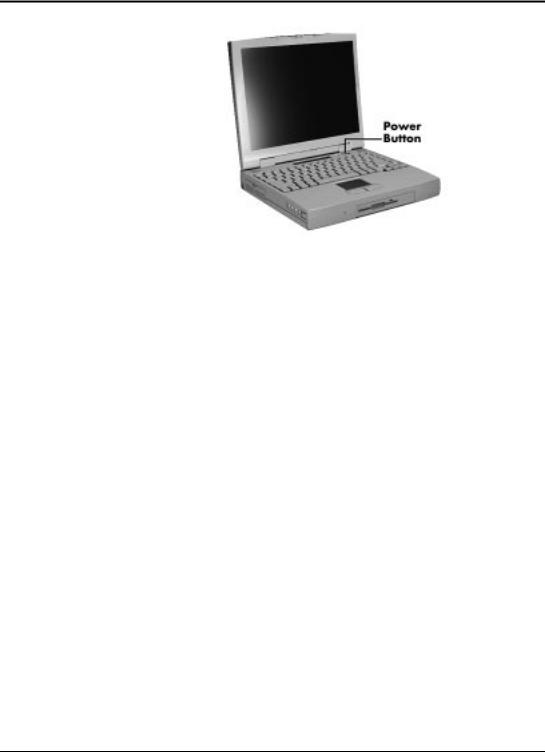
Powering on the system
Using the Main Battery Pack
The NEC Versa comes with a rechargeable Lithium-Ion (Li-Ion) battery pack. You can run your system on battery power for approximately two to four hours with power management features enabled. It's easy to install and remove.
Your NEC Versa system provides two tools to help you keep track of the main (or an optional) battery's power level. These include the battery percentage status described earlier in this chapter under “Status Icons” and the Power Gauge utility. Both let you know how much battery power remains.
When battery power is very low, the power LED flashes green.
When battery power gets low, do either of the following:
TPress the Suspend button to put your system in Suspend mode, remove the battery pack, and replace it with a fully charged Li-Ion battery.
TLeave the battery pack in the system and connect your NEC Versa to the AC adapter and a wall outlet. If you connect the system to AC power and keep the system within standard operating temperatures, the battery recharges in approximately 2 hours whether or not you use your system.
You can also buy an optional NEC Versa battery charger to quickly charge your battery. See the online Versa Tools: Accessories and Solutions Catalog.
1-16 Getting Started
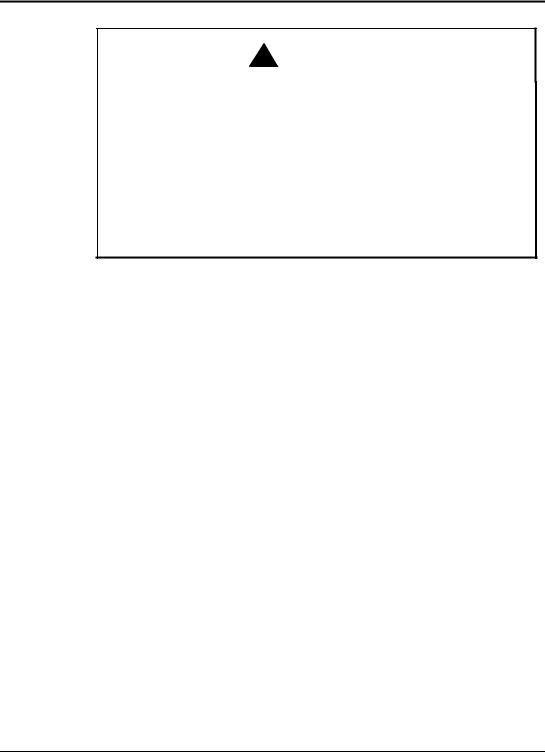
! WARNING
To prevent accidental battery ignition or explosion, adhere to the following:
TKeep the battery away from extreme heat.
TKeep metal objects away from the battery terminals to prevent a short circuit.
TMake sure the battery is properly installed in the battery bay.
TRead the precautions printed on the battery and in the online
Basics.
Determining Battery Status
You can determine battery status via the battery icon in the status bar discussed earlier in this chapter. If you have one battery pack installed, one battery icon appears. If you have two battery icons, two battery packs appear.
A blinking battery icon indicates that the battery is charging. Two dashes in place of the percentage number appear in the following cases:
Twhen installing a new battery
Twhen battery status is unknown
Twhen there is a problem with the battery.
To return the battery to its normal state, try the following:
Tremove and then reinstall the battery
Treinstall the battery in your NEC Versa and fully recharge the battery (to 100%).
The battery percentage icon blinks when battery power is low.
Getting Started 1-17

When to Change the Battery
The following symptoms indicate that battery life is nearing an end. Replace batteries that display these symptoms.
TShorter work times.
TDiscoloration, warping.
THot to the touch.
TStrange odor.
Battery Handling
Keep the following in mind when removing or replacing a battery.
TUse Li-Ion batteries only in the NEC Versa computer for which they are designed.
TUse only the Li-Ion battery designed for your system in the NEC Versa. Mixing other manufacturer’s batteries, or using a combination of very old and new batteries can deteriorate battery and equipment performance.
TTurn off power to the system after use. Keeping system power on can degrade battery performance and shorten battery life.
TClean the battery terminals with a dry cloth when they get dirty.
TKeep the battery out of the reach of children.
Replacing the Battery Pack
Replace the battery pack installed in your NEC Versa system as follows.
NOTE
Use Li-Ion batteries in the NEC Versa computer for which they are designed. Also, installing another manufacturer’s battery, or using a combination of very old and new batteries can deteriorate battery and equipment performance.
1-18 Getting Started
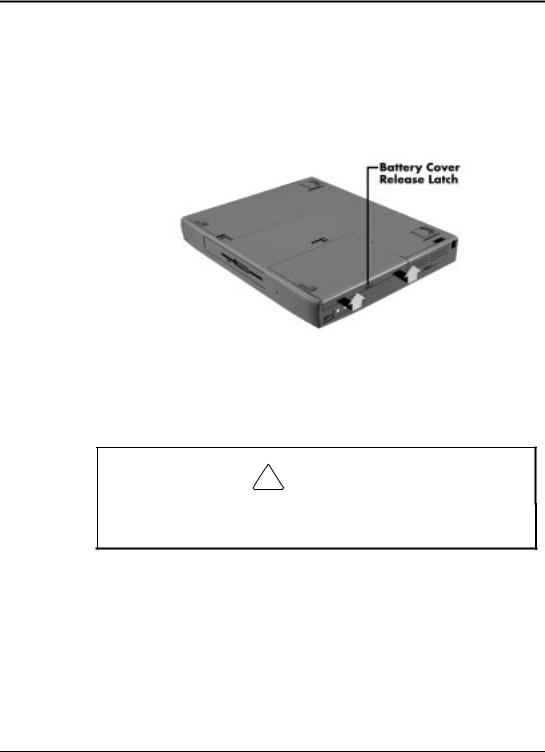
1.Save your files, exit Windows, and press the suspend button or turn off system power.
2.Close the LCD and turn the system over.
3.Release the battery cover latch and slide the battery bay cover away from the system.
Removing the cover
4.Place a finger in the notch on the battery and lift the battery out of the system. (The notch has an arrow next to it.)
! CAUTION
Always lift the battery out of the system by the notch. Failure to do so can damage the battery terminals.
Getting Started 1-19
